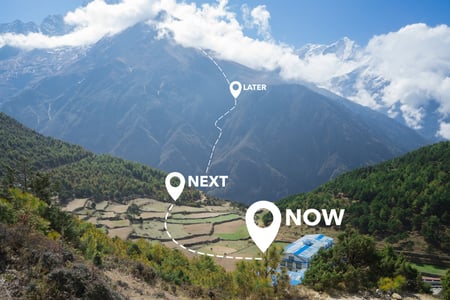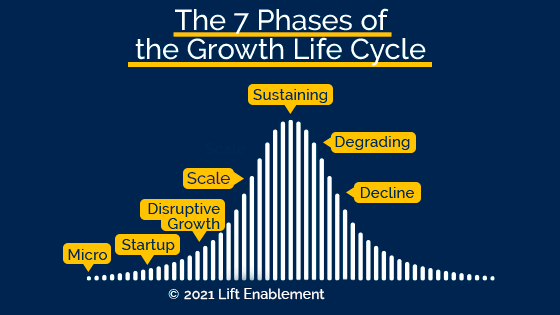 I love maps. That’s because a good map enables you to plan, anticipate and adjust effectively. It’s probably why we do so much roadmapping at Imagine.
I love maps. That’s because a good map enables you to plan, anticipate and adjust effectively. It’s probably why we do so much roadmapping at Imagine.
One of the biggest challenges facing companies pursuing high growth is that no two journeys/experiences are the same. One of my favorite things about growth is that you’re constantly confronting situations that you’ve never experienced. While this lack of experience is a key contributor to what makes growth so exciting, it also makes it confusing and paralyzing.
When you have a map and you confront terrain you’ve never experienced or an “immovable object,” you can make adjustments, and keep moving forward confidently.
A good map creates context. When you lack context, it makes everything exponentially harder.
Over the decades I’ve had the opportunity to work firsthand with hundreds of growth companies, and I’ve studied thousands more. From this experience, I’ve put together a framework (yep, a map) to create the context required to navigate tough terrain.
Another way to look at this is to “play your game.” An important lesson I’ve learned advising growth companies is that each phase of growth is, itself, a unique game. Each phase has different rules, and you, the player, have different assets to utilize.
It’s my hope that this framework will help you to identify where you are, where you want to be and allow you to chart your path to your destination.

Micro
This is where we all (or at least, most of us) start. Sometimes it begins with just an idea, a couple of customers, or some key people to build a team. The micro stage is a valuable one for growth companies as it provides a simple testing ground with little chance of failure. After all, you can’t lose what you don’t have.
The micro stage was valuable to me when I started Imagine. If I remember correctly, we were working with our third customer when I realized that my founding vision wasn’t going to work.
The biggest challenge in the micro phase is that you lack the funding, revenue, or cash flow to be a viable business with the ability to invest in its future growth capabilities. The value of the micro-phase is that you’re able to test your ideas in the real world, with real people who are in a position to write checks (or Venmo 😆) for what you’re offering.
The Focus: find a viable growth path & model to commit to
|
Opportunities |
Dangers |
|
|
Startup
You’re generating enough revenue (or you’ve raised enough money) to be a viable business. But, unfortunately, the startup phase is the most turbulent and destabilized phase in the business life cycle.
At this point, no matter how great your offering is, you haven’t yet built evidence that your market sees enough value to buy from you at the rates you need to grow.
This is why the startup phase is all about achieving product-market fit. A word of caution, the pursuit of its product-market fit can lead to several false exits where it appears that you’ve attained fit when you haven’t. It’s essential to pay attention to how you exit the startup phase, as how you exit will exert significant influence on the rest of your business life cycle.
The Focus: achieve product-market fit
|
Opportunities |
Dangers |
|
|
Disruptive
In my experience, this phase is often overlooked by growth strategists and business executives. Yet, it’s the phase where the vast majority of growth-focused businesses find themselves trapped.
Just because you have demonstrated/achieved product-market fit does not mean that it is ready or even on course to scale. But, far too often, companies behave as though it does.
The disruptive growth phase is best described as a period where a company continues to experience growth, frequently even strong growth; however, the effort, resources, and costs to achieve that growth continue to increase, typically faster than the growth itself. For those familiar with Les McKeown’s Predictable Success framework, the disruptive phase has a lot in common with the Whitewater phase.
It’s a frustrating and dangerous time because there is little to no predictability. However, note that this doesn’t mean that the company doesn’t hit its growth targets. Quite the contrary: hitting growth targets often disguises the early signs of the disruptive phase and exemplifies the “false exits” I referred to in the startup phase.
The question isn’t whether you’re hitting your targets. Here’s what you should be asking:
- Are you hitting them in the manner you predicted?
- Is your “growth math” clear?
- Is your structure (and underlying processes) repeatable & sustainable?
The Focus: repeatable & sustainable structure & model
|
Opportunities |
Dangers |
|
|
Scale-up
Step on the gas and grow!
For the serious growth executive, the scale-up phase is what it’s all about. You’ve got a strong product-market fit, your growth model is clear, and your processes are robust. Your concerns have shifted from creating enough demand to meet your objectives to simply keeping up with demand that seems to be multiplying every week (or day). It’s what noted growth strategist Geoffrey Moore refers to as the Tornado phase.
While the disruptive phase feels like you’re pedaling up an Alpine mountain in the Tour de France, the scale-up phase feels like the ride down. Realize that while your outputs are multiplying relative to your inputs, there are some crucial areas to pay attention to:
- The company transforms (often multiple times) during the scale-up phase
- What got you to scale up isn’t enough to get you through it
The Focus: Growth! Growth! Growth! Step on the gas & accelerate
|
Opportunities |
Dangers |
|
|
Sustaining
This is the most stable phase of the journey. Sustaining-growth organizations can match the proper resources to opportunities, have established a solid foundation, and have generated the leadership and momentum that enables them to grow almost effortlessly. The Sustaining phase can last years, or decades, if you continue putting the effort in; you’re now an incumbent in your industry, and new competitors in the Micro, Startup, Disruptive and Scale-up stages of growth are gunning for your market share.
The biggest dangers facing a sustaining growth organization are complacency and shifts in the market (from either a new entrant/approach or a dynamic change in the underlying market).
The Focus: Optimization & profit maximization
|
Opportunities |
Dangers |
|
|
Degrading
In February 2007, Howard Shultz, CEO of Starbucks, sent an email to his entire senior team with the subject: The Commoditization of the Starbucks Experience. In the email, he shared how he felt the “Starbucks experience” had degraded; most of these factors were primarily caused by steps to operate more efficiently.
Starbucks in 2006/2007 is one of the best examples of the degrading phase. (In their case, they successfully recovered and shifted back into the sustaining growth stage.)
The degrading phase is so dangerous because it’s so easy to miss. Profits are good and are often rising. In the early stages of the degrading phase, most--if not all--financial metrics show improvements. The organization is becoming more efficient.
The problem is the core focus of the company’s go-to-market strategy has shifted from value creation to value extraction. They raise prices and “monetize” because they can, not because they’re creating more impact.
The Focus: re-centering the company & value proposition around core areas of value creation
|
Opportunities |
Dangers |
|
|
Decline
By the time a company gets to the decline phase, it’s too late. The only viable strategy is typically to split the company in some fashion with the sustainably successful core business moving to a mature, non-growth focus approach and the remainder of the company “reinvented” to either the startup or scale-up phases.
|
Opportunities |
Dangers |
|
|
Now you understand the various terrains you might encounter on your journey. The good news is that no object is truly “immovable.” But, unless you use a map, you’re likely to wander into dangerous territory. This framework should give you the roadmap you need to not only avoid the pitfalls along the way, but to find success.

 Doug Davidoff
Doug Davidoff
